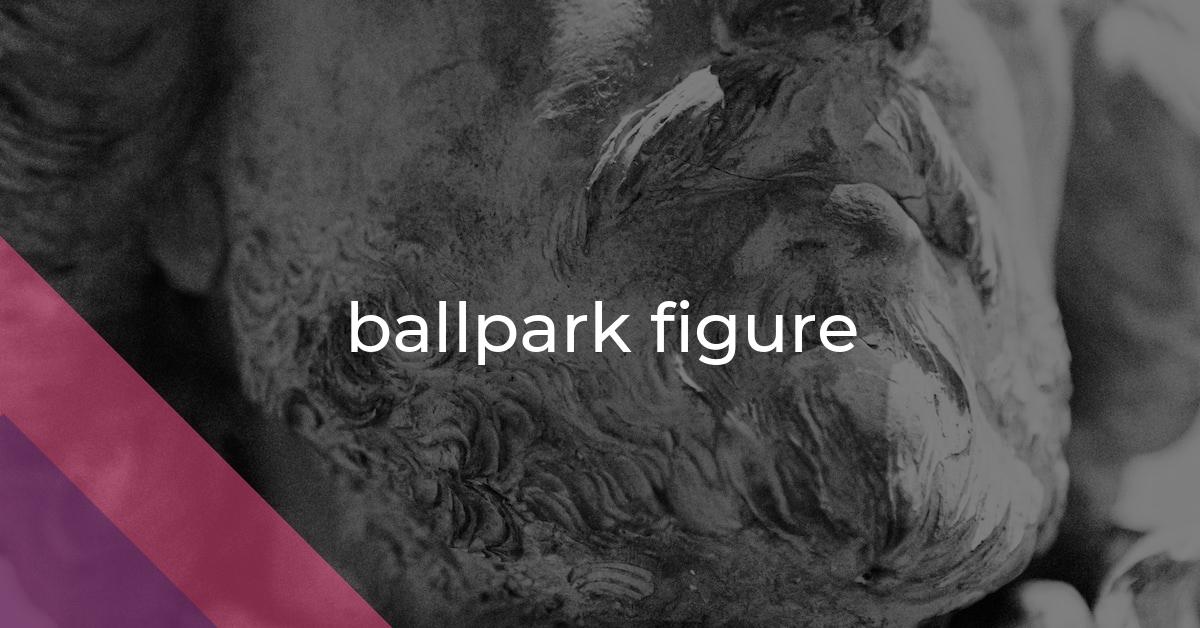ballpark figure: Idiom Meaning and Origin
What does ‘ballpark figure’ mean?
A 'ballpark figure' is a rough estimate or approximation of a number, used when an exact figure is not known or required.

Idiom Explorer
The idiom "something like" is used to indicate an approximation or estimate of something without providing exact or precise details.
The idiom "I'd say" is used to express an opinion or estimate based on one's judgment or perception, often without definitive or factual evidence. It signifies a personal assessment or guess about a situation or statement.
The idiom "hit one out of the ballpark" means to achieve outstanding success or accomplish something extremely impressive or remarkable.
The idiom *ground ball with eyes* refers to a baseball hit that bounces close the ground and narrowly avoids being caught by fielders. It is used metaphorically to describe something difficult to catch or control.
The idiom "great deal" means a large amount or quantity of something. It is used to indicate that there is a significant or considerable extent or degree of something.
The idiom "grand total" means the final sum or amount, usually of a series of numbers or quantities, representing the total or overall result.
A "grain of truth" is a small amount of truth or validity behind a statement or belief, even if it may be mostly false or exaggerated.
The idiom "good value" refers to something that is worth the money spent on it, providing a high quality or benefit relative to its cost.
"Go figure" is an idiomatic expression used to imply that something is surprising or difficult to understand.
The idiom *fudge factor* refers to an adjustment made to a calculation or a set of data in order to account for errors, uncertainties, or personal bias. It implies that the adjustment may not be completely accurate or reliable.
Decoding the Estimation Technique
Ballpark figure is an idiomatic expression widely used in American English. It refers to an approximate or rough estimate of a number or quantity. The phrase has its origins in baseball, specifically in estimating attendance figures at baseball games. However, it has since expanded beyond the realm of sports and is now commonly used in various fields and everyday conversations to convey a sense of approximation.
The term "ballpark figure" first appeared in American newspapers in the 1950s. Initially, it was used in a literal sense to describe estimated numbers related to baseball, such as attendance figures or stadium capacities. Over time, its usage broadened and extended into other contexts, becoming a popular idiomatic phrase to express approximate values in different areas of life.
So how did the phrase "ballpark figure" come to be associated with estimation? The metaphorical use of the term is rooted in the idea that when you attend a baseball game, it's impractical to count each individual in the stadium. Instead, people make rough estimates based on their judgment and experience. Similarly, when someone uses the phrase "ballpark figure," they are indicating that the number or estimate they are providing is a rough approximation rather than an exact calculation.
While the exact reasons behind the metaphorical extension of "ballpark figure" beyond baseball remain unclear, it is likely that the phrase became prevalent due to its simplicity and intuitive connection to estimation. The notion of a ballpark, as a space where large numbers of people gather, lends itself well to conveying the idea of rough estimates in various contexts.
The usage of "ballpark figure" has expanded into domains such as business, finance, and everyday conversation. Professionals use this phrase to communicate rough estimations, forecasts, or projections. For example, a financial analyst might use the phrase to provide a preliminary assessment of potential investment returns, or a project manager might rely on it to give a general idea of the budget required for a new initiative.
The popularity of "ballpark figure" can be attributed to its versatility and adaptability across fields and subjects. It serves as a convenient shorthand to emphasize approximation and acknowledges the limitations of precise calculation in certain situations. As a result, the phrase has become embedded in American English vernacular, making it an idiomatic expression with a distinct presence in both formal and informal communication.
However, it is important to approach the use of "ballpark figure" with caution. While it can be valuable for conveying rough estimates and facilitating discussions, seeking more precise data and calculations is always advisable when necessary. The phrase reminds us of the inherent uncertainties and complexities of quantification, urging us to remain diligent in our pursuit of accuracy and clarity.
In addition to "ballpark figure," there are several related idioms that convey a similar sense of approximation. One such idiom is "ballpark estimate." This phrase is often used interchangeably with "ballpark figure" to refer to a rough or approximate estimate. Both idioms convey the idea that the numbers or estimates provided are not exact calculations but rather educated guesses.
Another related idiom is "back-of-the-envelope." This expression is derived from the practice of doing quick calculations on the back of an envelope. It is often used to describe rough calculations or estimations made without extensive analysis or detailed information. Similar to "ballpark figure" and "ballpark estimate," "back-of-the-envelope" conveys the notion of approximation and the limitations of precise calculation.
Additionally, the phrase "something like" is often used to indicate an approximation or rough estimation. When someone says "it will cost something like $100," they are suggesting that the actual cost may vary slightly but will be around that amount. This phrase allows for a degree of flexibility and acknowledges the inherent uncertainties involved in estimation.
These related idioms, along with "ballpark figure," all serve to convey a sense of approximation and highlight the limitations of exact calculation in certain situations. They provide a shorthand for expressing rough estimates and help to facilitate understanding and communication in various fields and everyday conversations.
Example usage
Examples of how the idiom "ballpark figure" can be used in a sentence:
1. The financial analyst estimated that the cost of the new project would be around $500,000, but emphasized that it was just a ballpark figure.
2. The salesman gave the customer a ballpark figure for the price of the car, stating that it would be between $30,000 and $35,000.
3. When asked about the number of attendees expected for the conference, the event planner provided a ballpark figure of around 500.
More "Estimation" idioms



